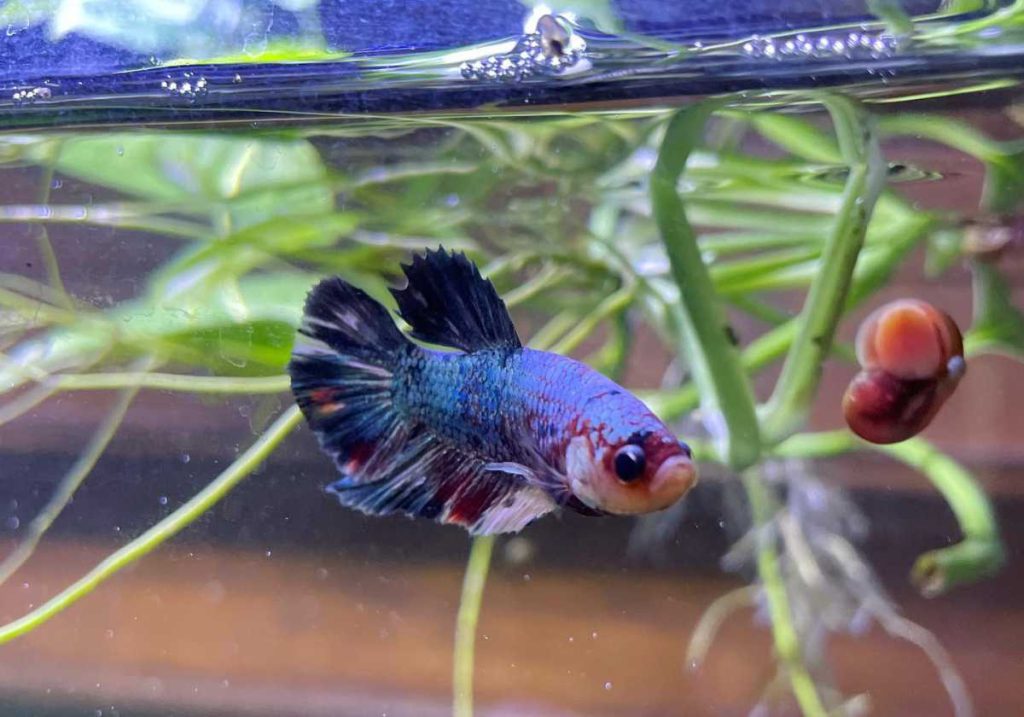As an Affiliate, We may earn a commission that doesn't cost you extra from qualifying purchases using links in this post. It helps keeps this blog running.
Imagine your shiny new fish tank is all setup, the water sparkles like a crystal-clear oasis, and you’re buzzing with excitement to welcome a Betta fish into its cozy abode. But hold on a minute – before you pop that beautiful Betta into its new home, there’s a crucial step you don’t want to skip. We’re talking about the delicate art of acclimation, the secret sauce that ensures your Betta’s smooth transition into its aquatic paradise to avoid the infamous Betta fish new tank syndrome.
Why is this acclimation process so vital? Well, think of it as the equivalent of a red carpet welcome for your Betta buddy. It’s not just about making your new fish feel like a VIP, but also about their overall well-being and happiness. In this article, we’ll dive into the nitty-gritty of how long you should wait before introducing your Betta to its new tank and why doing it right is the key to a thriving underwater friendship. So, gear up, because your Betta’s about to move into its swanky new pad, and we’re here to make sure it’s a grand entrance worth remembering!
How Long To Wait Before Adding Betta To New Tank – 24hrs Or 2 Weeks?
The appropriate time to wait before adding a betta fish to a new tank is generally around 24 hours, not necessarily 2 weeks. This 24-hour period allows the water temperature and conditions to stabilize after setting up the tank. However, it’s important to note that the water parameters, such as temperature, pH, ammonia, nitrite, and nitrate levels, should also be tested to ensure they are suitable for the betta fish.
A 2-week period may be more relevant when establishing a new aquarium’s nitrogen cycle. This cycle is the process of beneficial bacteria colonizing the tank, which helps convert harmful ammonia from fish waste into less toxic substances. It can take about 2 weeks or longer for this cycle to establish, during which time ammonia and nitrite levels can spike before stabilizing. It’s crucial to monitor these levels and only add fish once ammonia and nitrite readings are consistently at safe levels (close to zero).
So, in summary, wait for around 24 hours to stabilize the temperature and let the tank settle before adding a betta fish. However, ensure that the tank’s water parameters are suitable for the fish, and if the tank is newly set up, be prepared to wait for about 2 weeks for the nitrogen cycle to establish before introducing any fish.
How Long To Wait To Put Betta Fish In Tank After Conditioner
After treating water with conditioner, it’s generally recommended to wait for about 15-30 minutes before adding betta fish to the tank. This allows the conditioner to neutralize harmful chemicals like chlorine and chloramine, making the water safe for the fish. The waiting time can vary based on the specific brand of conditioner and the volume of water being treated. It’s essential to follow the instructions on the conditioner label for precise guidance.
Rapid introduction of fish after treating the water could stress or harm the betta fish due to residual chemicals. It’s advisable to monitor and double-check the new tank water parameters to ensure they are within the suitable range for your betta fish before adding them to the tank.
10 Factors Affecting the Waiting Period of Adding Betta Fish To A New Tank
The waiting period before adding a betta fish to a new tank can be influenced by several factors. These factors are important to consider to ensure a healthy and safe environment for the fish.
Here are the key factors that affect the waiting period:
1) Nitrogen Cycle:
The primary factor is the establishment of the nitrogen cycle. This natural biological process involves the growth of beneficial bacteria that convert toxic ammonia from fish waste into less harmful nitrites and then into nitrates. It can take about 2 weeks or more for this cycle to complete, during which ammonia and nitrite levels may spike. Waiting for this cycle to stabilize is crucial to prevent harm to the fish.
2) Water Parameters:
Water quality is vital for the well-being of betta fish. Parameters such as temperature, pH, ammonia, nitrite, and nitrate levels must be tested and adjusted if necessary. Waiting for these parameters to stabilize within safe ranges is essential before introducing the fish.
3) Temperature Stabilization:
Betta fish are sensitive to temperature changes. Allowing the tank’s water temperature to stabilize ensures that sudden fluctuations won’t stress the fish. This typically takes around 24 hours after setting up the tank.
4) Aquascape Preparation:
If you’re adding decorations, substrate, or live plants to the tank, these elements can influence water conditions. Waiting for any potential changes caused by these additions to settle is important before introducing the fish.
5) Chlorine Removal:
If you’re using tap water, chlorine, and chloramine present in the water can harm fish. Treating the water with a dechlorinator and allowing it to sit for a few hours before adding the fish helps remove these harmful chemicals.
6) Beneficial Bacteria Seeding:
If you have established aquariums with healthy bacterial colonies, you might use some filter media or substrate from those tanks to “seed” the new tank with beneficial bacteria. This can help accelerate the nitrogen cycle and reduce the waiting period.
7) Plant and Algae Growth:
If you’re planning to have live plants in the tank, allowing them some time to establish their root systems and start absorbing nutrients can contribute to a more stable tank environment.
8) Fishless Cycling:
Some aquarists choose to perform a “fishless cycling” process, where they add a source of ammonia to the tank to encourage the growth of beneficial bacteria. This allows the nitrogen cycle to establish without subjecting fish to potential ammonia and nitrite spikes.
9) Tank Size and Space:
The size of the tank matters for the well-being of your betta fish. A larger tank provides more stable water conditions and space for the fish to swim and explore. Smaller tanks can experience water parameter fluctuations more rapidly, which might affect the waiting period. In larger tanks, the water conditions tend to be more forgiving, potentially requiring less time to stabilize before introducing the fish.
10) Filtration System:
The filtration system plays a crucial role in maintaining water quality. A well-functioning filter helps remove waste and toxins, contributing to a healthier environment for the fish. It’s recommended to let the filtration system run for a period before adding the betta fish. This allows the filter media to establish beneficial bacteria colonies that aid in breaking down harmful substances. The waiting time might vary based on the efficiency and size of the filtration system.
Do You Have To Wait Till The Water’s Nitrogen Is Complete Before Adding Your Betta Fish?
No, you do not need to wait until the water’s nitrogen cycle is complete before adding your betta fish to your aquarium. However, it’s crucial to understand the nitrogen cycle and its importance in maintaining a healthy aquatic environment for your fish.
The nitrogen cycle involves the conversion of toxic ammonia (produced by fish waste and decaying organic matter) into less harmful compounds like nitrite and finally into nitrate. Beneficial bacteria play a vital role in this process. These bacteria need time to establish themselves in your aquarium, and this process is known as “cycling” the tank.
Adding fish to an uncycled tank is a kind of gamble because it can lead to ammonia and nitrite spikes, which are harmful to fish and can even be fatal. While some fish will not react to these spikes, some will become very stressed and their life may be cut short. Therefore, it’s generally recommended to cycle your aquarium before introducing fish. This can take several weeks.
If you choose to add fish immediately, you can use products that contain beneficial bacteria to speed up the cycling process. However, it’s essential to closely monitor the water parameters (ammonia, nitrite, and nitrate levels) and perform water changes as needed to keep these levels safe for your fish.
What are the Signs of a Ready Betta Fish Tank?
Recognizing when a tank is ready for the addition of fish, particularly betta fish, is crucial for their health and well-being. Here are the signs of a well-cycled and ready tank, including both visual and water parameter cues:
Visual Cues of a Ready Betta Fish Tank:
- Clear Water: The water should be clear and free of cloudiness or haziness. Cloudy water can indicate an ongoing bacterial bloom or an incomplete nitrogen cycle.
- Stable Algae Growth: Some level of algae growth is normal and even beneficial, as it indicates the presence of nutrients in the water. However, excessive algae blooms might suggest imbalances in the tank.
- Plant Health: If you have live plants, their growth should be healthy and steady. Lush and vibrant plant growth is a positive sign of a well-balanced ecosystem.
- Active Microfauna: You might notice tiny organisms like copepods or small snails. These microfauna indicate a diverse and established ecosystem.
- Absence of Foul Odor: A well-cycled tank should not emit any foul or strong odors. Foul smells can indicate high levels of ammonia or other pollutants.
Water Parameter Cues of a Ready Betta Fish Tank:
- Ammonia and Nitrite Levels: Ammonia and nitrite levels should be consistently close to zero. These toxic compounds should have been effectively converted by the beneficial bacteria present in a mature tank.
- Nitrate Levels: Nitrate levels should be present, as they are the end product of the nitrogen cycle. However, high nitrate levels can indicate that regular water changes are needed to prevent accumulation.
- pH Stability: The pH level should remain relatively stable within the acceptable range for betta fish. Rapid pH fluctuations can stress fish.
- Temperature Stability: The water temperature should remain stable within the recommended range for betta fish. Sudden temperature fluctuations can be harmful.
7 Potential Risks of Rushing Betta Fish To A New Tank:
Rushing the introduction of a betta fish to an uncycled tank can have serious consequences for the well-being of the fish. This practice can lead to stress, health issues, and even fatalities due to unfavorable water conditions. Here’s an overview of the potential risks:
- Ammonia and Nitrite Toxicity: In an uncycled tank, ammonia levels can spike due to fish waste and uneaten food. Ammonia is highly toxic to fish and can lead to severe stress, irritation, and damage to the fish’s gills and overall health. To add to that, as the nitrogen cycle isn’t fully established, there won’t be sufficient beneficial bacteria to convert ammonia into nitrites and then into nitrates. Elevated nitrite levels can also harm fish by interfering with their blood’s ability to carry oxygen.
- Stress and Reduced Immunity: Rapid changes in water parameters, such as temperature and pH, can stress betta fish. Stress weakens the fish’s immune system, making them more susceptible to infections and diseases. Stress can manifest as loss of appetite, lethargy, color fading, and increased vulnerability to parasites.
- Respiratory Problems: High ammonia and nitrite levels affect the gills of fish, making it difficult for them to extract oxygen from the water. This can result in labored breathing, gasping at the water’s surface, and overall respiratory distress.
- Fin Rot and Fungal Infections: Stress and poor water quality create an environment conducive to fin rot and fungal infections. These conditions can lead to frayed fins, white patches on the body, and open wounds, all of which compromise the fish’s health.
- Behavioral Changes: Betta fish may exhibit abnormal behaviors in an uncycled tank, such as excessive hiding, lethargy, or aggression. Stress-induced aggression might result in fights with tankmates, if present, leading to injuries.
- Weakened Health and Reduced Lifespan: Continuous exposure to stressful and poor water conditions can significantly weaken a betta fish’s health. It may develop chronic health problems that can ultimately shorten its lifespan.
- Increased Mortality: The culmination of these negative effects can ultimately lead to fish fatalities. Fish introduced to an uncycled tank are at a higher risk of becoming seriously ill and not surviving in the long term.
To mitigate these risks, it’s essential to properly cycle the tank before introducing any fish. This involves allowing beneficial bacteria to establish and effectively convert harmful ammonia and nitrite into less toxic nitrates. This process usually takes a couple of weeks. Regular monitoring of water parameters and performing water changes can help maintain a healthier environment for the fish.
Remember that the well-being of your betta fish depends on providing suitable and stress-free habitat, and rushing the introduction process can have dire consequences.

I’m Akin Bouchard. Even though I now own several different fish species, I first became a koi pond owner because I loved these creatures and wanted to turn my passion into something more serious. I take pride in my collection of koi fish and love sharing my knowledge with others interested in these beautiful creatures.
A Comprehensive Guide to Training Your Fish to Perform Amazing Tricks Feats




